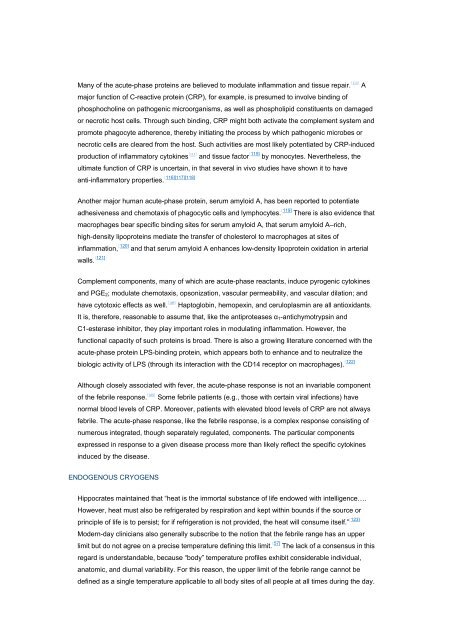Temperature Regulation and the Pathogenesis of Fever
Temperature Regulation and the Pathogenesis of Fever
Temperature Regulation and the Pathogenesis of Fever
You also want an ePaper? Increase the reach of your titles
YUMPU automatically turns print PDFs into web optimized ePapers that Google loves.
Many <strong>of</strong> <strong>the</strong> acute-phase proteins are believed to modulate inflammation <strong>and</strong> tissue repair. [113] A<br />
major function <strong>of</strong> C-reactive protein (CRP), for example, is presumed to involve binding <strong>of</strong><br />
phosphocholine on pathogenic microorganisms, as well as phospholipid constituents on damaged<br />
or necrotic host cells. Through such binding, CRP might both activate <strong>the</strong> complement system <strong>and</strong><br />
promote phagocyte adherence, <strong>the</strong>reby initiating <strong>the</strong> process by which pathogenic microbes or<br />
necrotic cells are cleared from <strong>the</strong> host. Such activities are most likely potentiated by CRP-induced<br />
production <strong>of</strong> inflammatory cytokines [114] <strong>and</strong> tissue factor [115] by monocytes. Never<strong>the</strong>less, <strong>the</strong><br />
ultimate function <strong>of</strong> CRP is uncertain, in that several in vivo studies have shown it to have<br />
anti-inflammatory properties. [116][117][118]<br />
Ano<strong>the</strong>r major human acute-phase protein, serum amyloid A, has been reported to potentiate<br />
adhesiveness <strong>and</strong> chemotaxis <strong>of</strong> phagocytic cells <strong>and</strong> lymphocytes. [119] There is also evidence that<br />
macrophages bear specific binding sites for serum amyloid A, that serum amyloid A–rich,<br />
high-density lipoproteins mediate <strong>the</strong> transfer <strong>of</strong> cholesterol to macrophages at sites <strong>of</strong><br />
inflammation, [120] <strong>and</strong> that serum amyloid A enhances low-density lipoprotein oxidation in arterial<br />
walls. [121]<br />
Complement components, many <strong>of</strong> which are acute-phase reactants, induce pyrogenic cytokines<br />
<strong>and</strong> PGE2; modulate chemotaxis, opsonization, vascular permeability, <strong>and</strong> vascular dilation; <strong>and</strong><br />
have cytotoxic effects as well. [108] Haptoglobin, hemopexin, <strong>and</strong> ceruloplasmin are all antioxidants.<br />
It is, <strong>the</strong>refore, reasonable to assume that, like <strong>the</strong> antiproteases α1-antichymotrypsin <strong>and</strong><br />
C1-esterase inhibitor, <strong>the</strong>y play important roles in modulating inflammation. However, <strong>the</strong><br />
functional capacity <strong>of</strong> such proteins is broad. There is also a growing literature concerned with <strong>the</strong><br />
acute-phase protein LPS-binding protein, which appears both to enhance <strong>and</strong> to neutralize <strong>the</strong><br />
biologic activity <strong>of</strong> LPS (through its interaction with <strong>the</strong> CD14 receptor on macrophages). [122]<br />
Although closely associated with fever, <strong>the</strong> acute-phase response is not an invariable component<br />
<strong>of</strong> <strong>the</strong> febrile response. [108] Some febrile patients (e.g., those with certain viral infections) have<br />
normal blood levels <strong>of</strong> CRP. Moreover, patients with elevated blood levels <strong>of</strong> CRP are not always<br />
febrile. The acute-phase response, like <strong>the</strong> febrile response, is a complex response consisting <strong>of</strong><br />
numerous integrated, though separately regulated, components. The particular components<br />
expressed in response to a given disease process more than likely reflect <strong>the</strong> specific cytokines<br />
induced by <strong>the</strong> disease.<br />
ENDOGENOUS CRYOGENS<br />
Hippocrates maintained that “heat is <strong>the</strong> immortal substance <strong>of</strong> life endowed with intelligence….<br />
However, heat must also be refrigerated by respiration <strong>and</strong> kept within bounds if <strong>the</strong> source or<br />
principle <strong>of</strong> life is to persist; for if refrigeration is not provided, <strong>the</strong> heat will consume itself.” [123]<br />
Modern-day clinicians also generally subscribe to <strong>the</strong> notion that <strong>the</strong> febrile range has an upper<br />
limit but do not agree on a precise temperature defining this limit. [57] The lack <strong>of</strong> a consensus in this<br />
regard is underst<strong>and</strong>able, because “body” temperature pr<strong>of</strong>iles exhibit considerable individual,<br />
anatomic, <strong>and</strong> diurnal variability. For this reason, <strong>the</strong> upper limit <strong>of</strong> <strong>the</strong> febrile range cannot be<br />
defined as a single temperature applicable to all body sites <strong>of</strong> all people at all times during <strong>the</strong> day.


